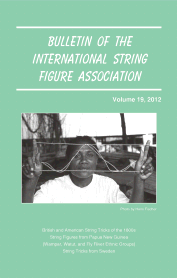Volume 19 (2012) - Table des Matières
Edité par - Mark A. Sherman, Pasadena, California
Rédacteurs Associés - Joseph D'Antoni, Queens, New York; Myriam Namolaru, Haifa, Israel;
Belinda Holbrook, Davenport, Iowa; Stephan Claassen, Best, Netherlands.
Comité de Rédaction - Hiroshi Noguchi, Tokyo, Japan; Philip Noble, Inverness, Ecosse
Le Bulletin de l'Association Internationale du Jeu de Ficelle (BISFA) est une publication savante
présentant des documents originaux qui fait progresser notre compréhension et renforce
notre plaisir des jeux de ficelle. BISFA est publié annuellement, en septembre, par ISFA Press
(Pasadena, Californie). BISFA remplace le Bulletin de l'Association des Jeux de Ficelle,
(Toky Nippon Ayatori Kyokai), qui a été publiée en 19 volumes (1978-1993).
Les traductions proposées ne comprennent pas les illustrations et photos du texte original.
J'ai traduit ces textes pour vous donner un aperçu de la qualité et de la richesse de
ces publications.

![]()
Research Reports
- British and American String Tricks of the 1800s by Martin Probert, Devonshire, UK (pages 1-11) - The first detailed descriptions of string tricks from non-Western peoples are those of Rivers and Haddon (1902). But, before the publication of that article, string tricks had been described in detail in works of the 1850s to 1870s written by European and American magicians. This article describes the string-figure tricks contained in three English-language publications. Of particular delight to the present author was his discovery, in one of these works, of ‘The Haymaker’s Trick’.
- String Figures of the Wampar in Papua New Guinea by Hans Fischer, Hamburg, Germany (pages 12-69) - The author presents the names, forms and context of 53 different string figures collected among the Wampar, an ethnic unit in the Morobe Province of today’s State of Papua New Guinea. Alongside he discusses questions of source criticism in ethnological field work and the consequences of cultural change. The string figures were recorded during various research periods in the region between 1958 and 2009. A new development in the area appears to be the occurrence of rubber band figures. The author presents photographs of seven of these figures.
- Hans Fischer’s Watut String Figure Collection Revisited by Stephan Claassen, Best, the Netherlands (pages 70-140) - In 1960 German ethnologist Hans Fischer published a fairly large collection of string figures which he collected in the Lower Watut and Banir River area of eastern Papua New Guinea. For most figures in the collection no construction methods were recorded, but twelve figures and one series of figures have instructions, usually in German, and sometimes also in the Watut language. Fischer further collected information on Watut terminology used to describe the construction of string figures. Due to the mixing of string figures with and string figures without instructions, and due to the use of the German language, the collection has undeservedly been neglected in string figure studies. Therefore in the current paper all Watut string figures from the 1960 collection that have instructions are presented. An interpretation of the original German and Watut instructions is given. Each figure is then followed by comparative remarks. A provisional analysis of Watut string figure terminology, based on Fischer’s material, concludes the paper. One of the figures (boromak) has only been found among the Watut and the neighboring Wampar. (figures)
- Some North Fly District String Figures collected and introduced by Philip D. Noble, Inverness, Scotland; transcribed and annotated by Stephan Claassen, Best, the Netherlands (pages 141-183) - In this collection seventeen different string figures and tricks are presented. These were photographed and recorded on video by Dorcas and Kevin McPhee, prior to Philip Noble’s 2006 trip to the Northern Fly District, Papua New Guinea. The continuation of a popular Oceanic figure appears to be unique, as is the construction method of a figure that is itself known from other parts of New Guinea. A small series, which has only been recorded before (in a more complex form) on Saibai Island, Torres Strait, is also presented.
- Swedish String Figures III: Nils Keyland’s Stockholm recordings of 1908 by Stephan Claassen, Best, the Netherlands (pages 184-199) - In 1908 Nils Keyland recorded seven string tricks in Stockholm, probably from a local bookkeeper. They are presented here. Each trick is compared with related tricks from Scandinavia. Most of the tricks are found in other parts of Sweden and Scandinavia; only one of them has probably not been recorded before. The paper uses material from Nordiska Museet, Stockholm, Sweden.
Book and DVD Reviews - by Joseph D'Antoni and Mark Sherman (pages 200-202)
- Brain power-up Ayatori, by Hiroshi Noguchi.
- Dave’s Favorites, with David Titus “The String Man”, DVD.
Letters to the Editor (pages 203-213)
- Two 1921 String Figures from Murray Island, Torres Straits - Stephan Claassen. A transcription of two string figures captured on film by Frank Hurley for his silent adventure series Pearls and Savages.
- L'histoire derrière 'Les Chiens de Lochiels'? - Philip D. Noble. Cette figure a été recueillie par le Réverend John Gray sur l'Ile d' Eriskay dans l'archipel des Hébrides Extérieures. Etant donné qu"elle était inclut dans le livre de Jayne String Figures (1906), ce motif et son nom insolite sont devenus très connus. Une légende écossaise qui pourrait etre la source du nom insolite de ce jeu de ficelle est présentée, ainsi qu'une brève biographie de Gray. (pas entièrement traduit)
- Navajo Star Lore Update - Alexei Andreev. After consulting a recently published book on Navajo Astronomy, the author was able to map four previously unidentified Navajo constellations that have corresponding string figures.
Nomenclature - by Mark Sherman (pages 214-229)
- Abbreviations and terms used throughout the Bulletin are summarized and illustrated. Step-by-step illustrations for making five string figures (Look!, Drum, Two Fawns, Face Mask, and Two Arrowheads) are provided as examples.
Ajouter un commentaire

